6 Best Types of Barbell Row Variations (with Pictures!)
Barbell rows are the ideal back building exercise - especially when the correct variation is selected.
However, this can quickly grow complicated when you take into account the sheer number of barbell row variants out there. Fortunately, we’ve selected the most effective ones and listed them in this article.
While all novice lifters should start out by mastering the conventional bent-over row, more advanced athletes may wish to try out the Pendlay row for greater intensity. Alternatively, exercises like the Yates row or the upright row can both target more than just the mid-back musculature.
What is a Barbell Row?
Barbell rows are a type of compound back exercise performed so as to build mass and strength in the muscles of the upper and middle back.
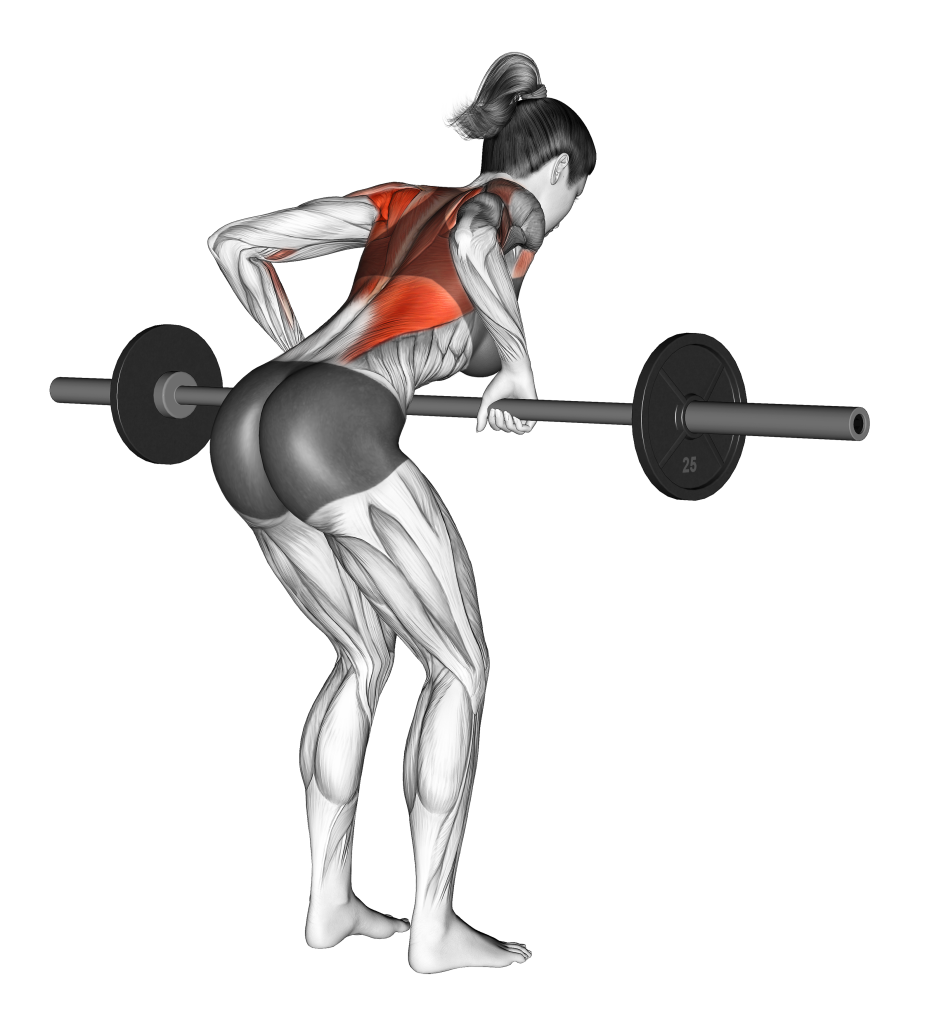
Depending on the particular variation, inclusion of muscle groups like the biceps brachii, erector spinae and the medial/anterior section of the deltoids can also be present. This, of course, is alongside muscles like the latissimus dorsi, trapezius, rhomboids and the rotator cuff muscles.
In most cases, a barbell-based rowing exercise will feature a horizontal pulling movement facilitated by elbow flexion and scapular retraction.
The majority of barbell row variations involve changes in the angle of the lifter’s torso, the grip used or the direction in which the lifter rows the barbell.
Barbell Row Variations
1. The Bent-Over Barbell Row
Otherwise simply referred to as “barbell rows”, the bent-over barbell row is the baseline variation that all lifters should first master prior to attempting more advanced variants.
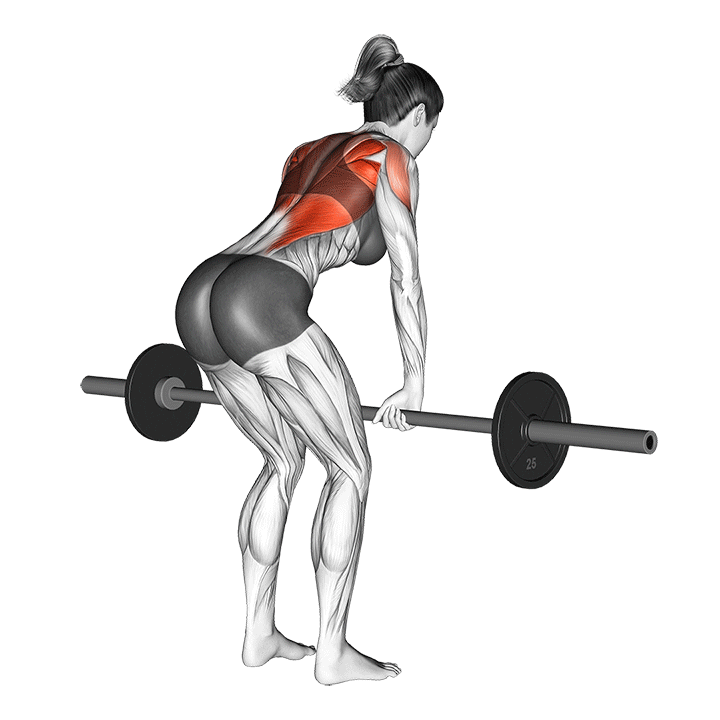
Like most other row variations, the bent-over row is an open chain compound movement performed for low to moderate amounts of volume.
Often, this particular type of row takes the place as the primary compound movement in a back workout - a result of its reliability and effectiveness at developing the back muscles.
Muscles Worked
Bent-over rows primarily target the latissimus dorsi, the teres muscles, trapezius, infraspinatus, rhomboids and the elbow flexor muscles of the arms. In addition, the posterior deltoid also plays a role.
Defining Benefits as a Row Variation
The main benefit to the conventional barbell row is its simplicity.
With a relatively standard range of motion and even distribution of load throughout the mid and upper back, the barbell row is both safe and effective for general training purposes.
In addition, barbell rows do not require an excessive forward hinge at the pelvis, an underhand grip or even a particularly wide range of motion. This makes them excellent as an introduction to rowing exercises as a whole.
How-to:
To perform a repetition of the barbell row, the lifter will hold a loaded barbell in pronated grip as they stand upright.
The hands should be set a comfortable distance around shoulder-width apart, feet hip-width apart for stability.
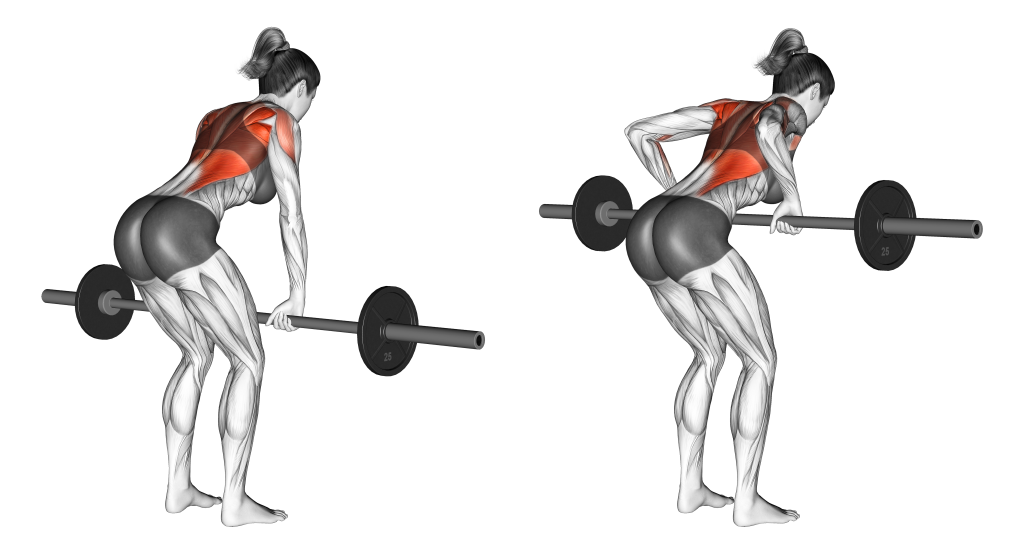
Then, contracting the core, the lifter will bend forwards at the hips as they keep their spine straight. Unlike other variations, the standard barbell row uses a 45 degree angle of torso flexion at most.
Once positioned appropriately, the lifter will then squeeze their back muscles and pull their elbows behind their torso, drawing the barbell towards their stomach as they do so.
When the elbows are behind the body and the barbell touches the stomach, the lifter will then slowly reverse the motion and lower their arms once again.
This completes the repetition.
2. The Pendlay Row
Pendlay rows are a more intense variation of conventional row where the lifter adopts a far more horizontal torso orientation and begins the repetition with a protracted scapula. These two seemingly small changes in stance greatly alter the range of motion and muscular recruitment of the exercise.
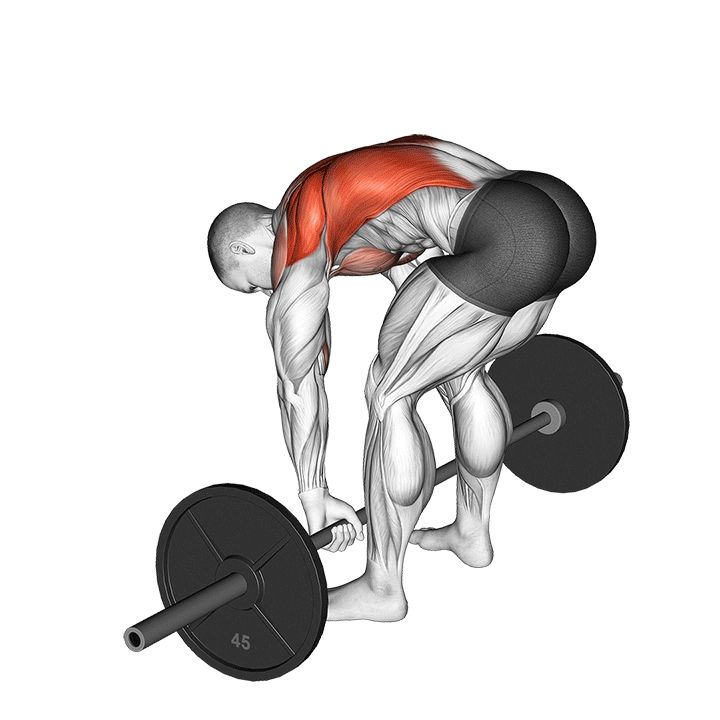
Apart from being superior in terms of muscular recruitment, the Pendlay row also excels at working the erector spinae and other lower back musculature due to the more strenuous position the torso is oriented in.
Muscles Worked
Pendlay rows, like conventional rows, target the latissimus dorsi, trapezius, the rhomboids and the teres muscles.
In addition, the posterior deltoids, elbow flexors, erector spinae and posterior deltoids all play a lesser role as well.
Defining Benefits as a Row Variation
As previously mentioned, the Pendlay row is a more intense and complex variation of the conventional barbell row. This makes it excellent for more advanced weightlifters or those that suffer from poor initial pulling strength at the start of other row variation repetitions.
How-to:
In order to perform a Pendlay row, the lifter will first stand upright with a loaded barbell held in a double overhand grip, feet set hip-width apart and knees bent.
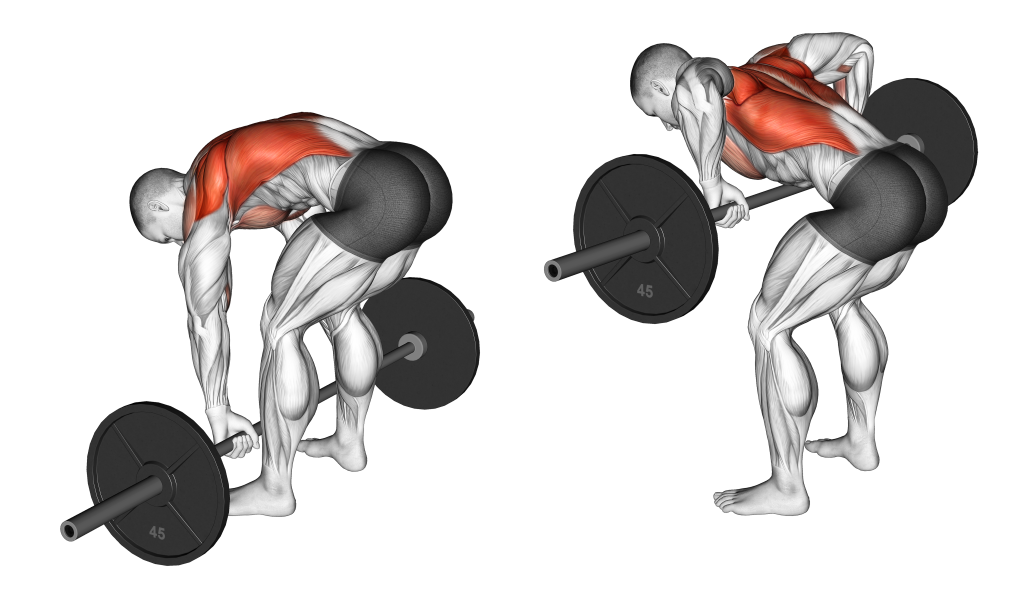
From this position, the lifter will then hinge at the hips and lever the torso forwards until the lower back is nearly parallel to the floor. The scapula should begin partially retracted, and the spine kept neutral with additional support from a braced core.
Now in the correct stance, the lifter will simultaneously retract their scapula and draw their elbows behind their torso.
This should pull the barbell towards the sternum or lower ribcage of the lifter - of which they will pull until it touches their torso.
To complete the repetition, the lifter will then slowly lower the arms back down, returning to the starting stance.
3. The Landmine Row/T-Bar Row
As one may be able to guess from its name, the T-bar row makes use of a landmine attachment and a T-bar handle. Lifters without access to the latter can simply grip the neck of the barbell instead.

Regardless, the landmine row is a variation of barbell row where the hands are set close together in a neutral orientation. This causes greater mid-back recruitment and shifts more emphasis towards the trapezius muscle.
Landmine rows are often used as either an alternative to the conventional row or as a secondary exercise to elicit greater mid-back development.
Muscles Worked
The landmine row excels as a method of targeting the lower trapezius, rhomboids, teres muscles and the infraspinatus.
However, like any other row, it will also target the latissimus dorsi, posterior deltoids and the elbow flexor muscles of the arms.
In particular, the brachialis and brachioradialis see greater recruitment on account of the neutral grip involved.
Defining Benefits as a Row Variation
Greater emphasis on the mid-back aside, the T-bar row is excellent for lifters who find that conventional rows irritate certain sections of their wrists, elbows or shoulders. This is further compounded by the reduced risk of lower back strain on account of the barbell’s angle of resistance.
How-to:
In order to perform a repetition of the landmine row, the lifter will first fix one end of a barbell into a landmine attachment, loading the other with plates and hooking a T-bar handle beneath.
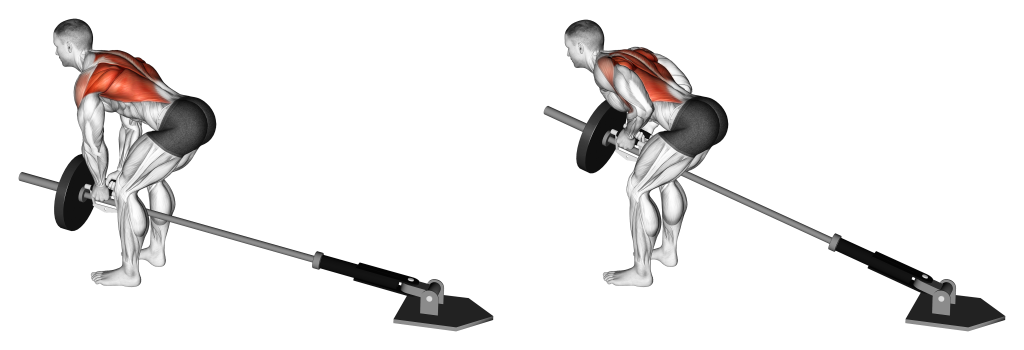
The lifter will position themselves over the neck of the barbell’s loaded end, gripping both sides of the T-bar handle and raising it upwards until their torso is at a 45 degree angle, spine neutral.
From this stance, the lifter will then draw their elbows behind their back, keeping them close to the sides of the torso as they do so. This should draw the barbell towards their stomach.
Once the elbows are at least parallel with the sides of the body, the lifter will simply reverse the motion so as to complete the repetition.
4. The Barbell Upright Row
Upright rows are a row variation meant to target the deltoids and emphasize the muscles of the upper back, rather than those of the mid-back. It achieves this shift in recruitment by having the lifter perform the exercise upright, drawing the barbell vertically upwards, rather than horizontally.
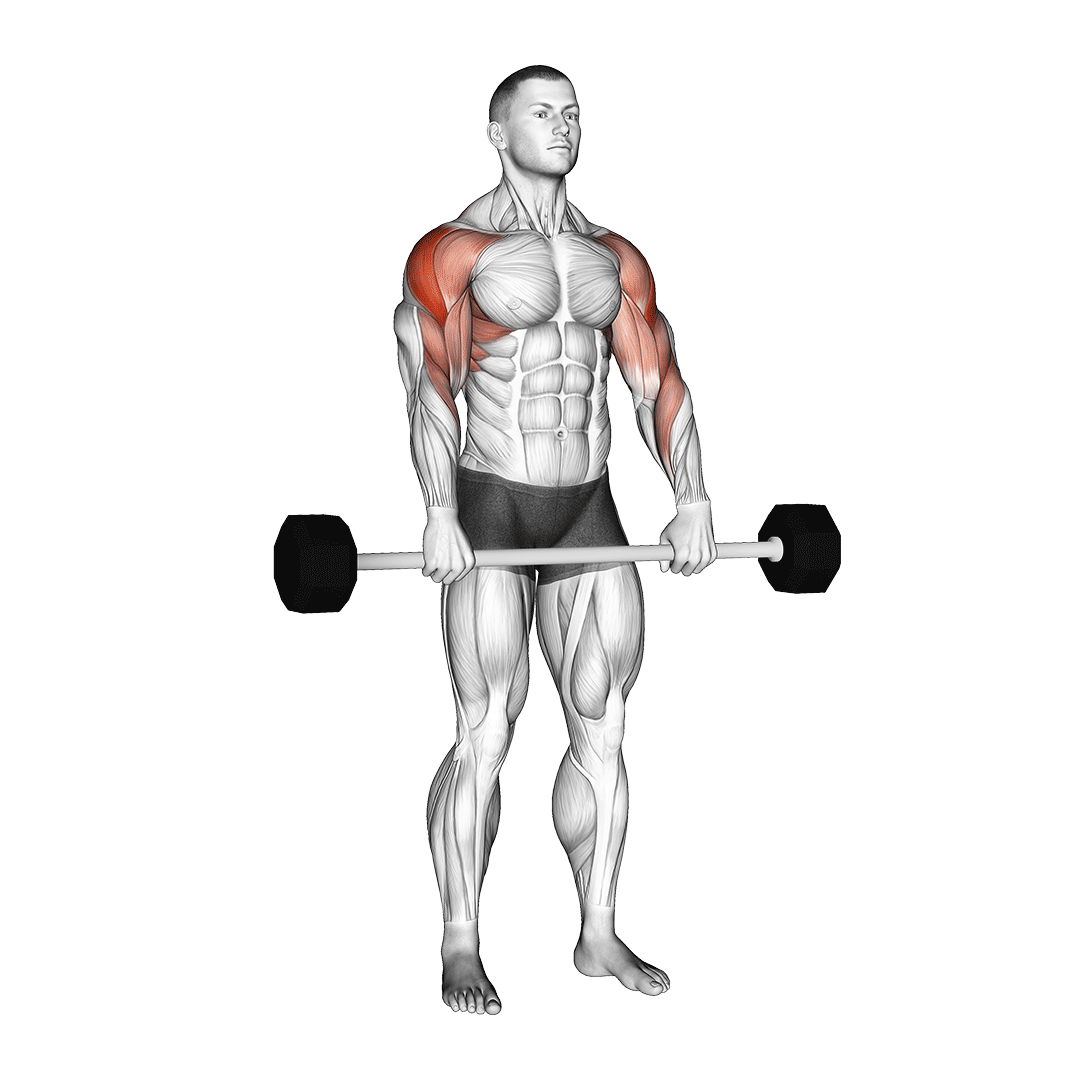
While controversial for its injury risk, barbell upright rows are undoubtedly effective at working the upper back and shoulders.
When performed with low amounts of weight and with additional attention paid to form, this injury risk can largely be mitigated.
Muscles Worked
Barbell upright rows primarily target the deltoids, biceps brachii, and the trapezius muscles.
Defining Benefits as a Row Variation
The most defining advantage to performing upright barbell rows is its reinforcement of muscle groups that are otherwise less focused on by other back exercises. The upper trapezius and medial deltoids in particular suffer from this issue.
In addition, upright rows in general feature a movement pattern that is uncommon among resistance exercises, despite its applicability to many real world activities.
How-to:
In order to perform a repetition of the barbell upright row, the lifter will stand upright with a loaded barbell held in a double overhand grip, hands shoulder-width apart.
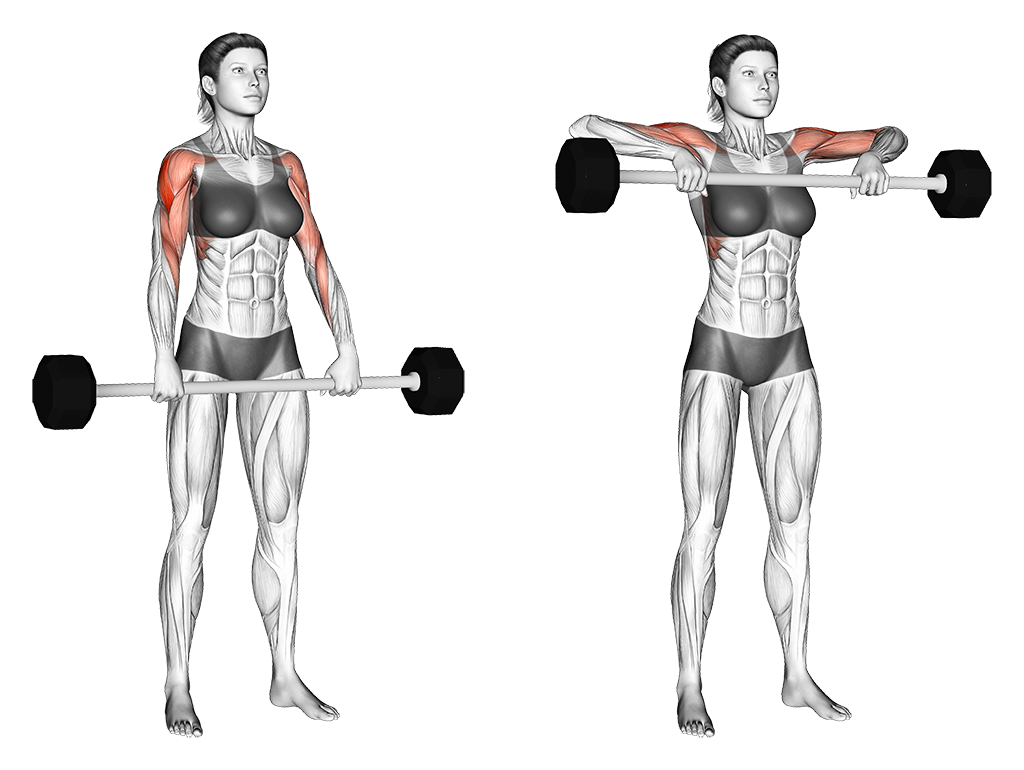
From this stance, the lifter then lifts the barbell upwards as they bend at the elbows, raising the upper arms out to the sides as they do so. Care should be taken to keep the upper spine neutral, and the head facing forwards.
Once the bar is beneath the chin, the lifter slowly reverses the motion so as to complete the repetition.
5. Barbell Yates Row
The barbell Yates row is simply a Pendlay row performed with an underhand grip, meaning that greater recruitment of the biceps takes place. This is in addition to its more horizontal angle of the torso.
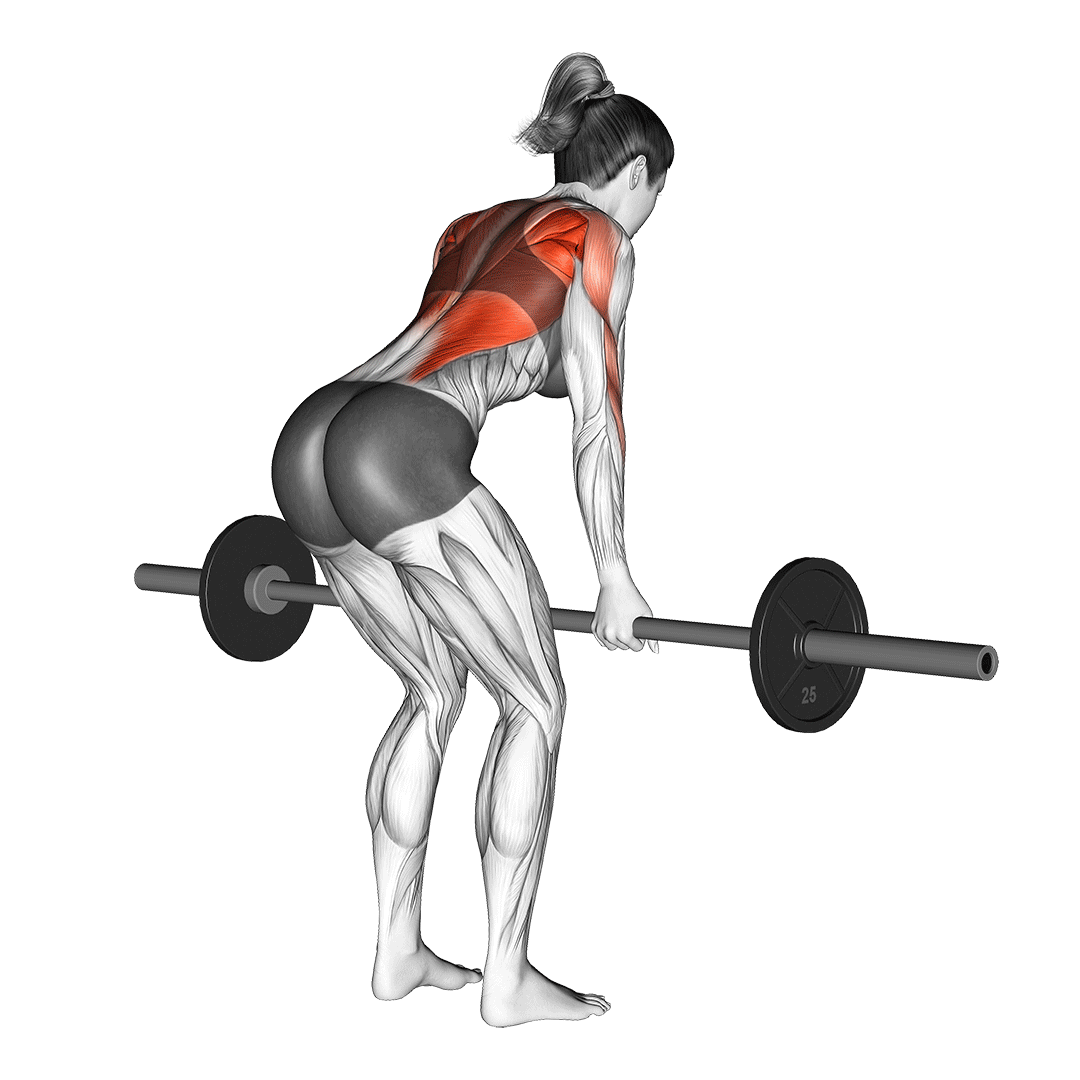
Otherwise, in terms of mechanics and pulling direction, the exercise is much the same as the Pendlay and conventional row.
While this change in grip does indeed mean that the elbow flexor muscles are developed to a greater degree, the Yates row is also the subject of controversy due to a supposed greater risk of biceps injury; Exercise caution when performing it.
Muscles Worked
Yates rows shift greater emphasis to the biceps brachii, but otherwise target the same muscles as a Pendlay row. This means the latissimus dorsi, trapezius, rhomboids and other mid-back musculature.
Defining Benefits as a Row Variation
The main benefit of performing Yates rows is its capacity to develop the biceps brachii due to its usage of an underhand grip.
In addition, it also places the lifter’s torso at a more horizontal angle, albeit not to the extent that an actual Pendlay row would use.
Both aspects of the Yates row make it superior to the conventional row for targeting certain pull muscles - hence its frequent usage as a progression exercise.
How-to:
To perform a Yates row, the lifter will assume the standard barbell row stance by placing their feet hip-width apart and holding a loaded barbell beneath them. This time, the hands should be in a supinated orientation, rather than a pronated one.

Barbell in hand, the lifter then hinges at the waist until the torso is nearly parallel with the floor, keeping the core braced and the spine neutral throughout the set.
Once in the correct stance, the lifter then performs the exercise as normal by drawing the barbell towards the base of their rib cage as they pull their elbows behind their body. When the barbell is touching their torso, they may then slowly lower it to complete the repetition.
6. Single Arm Landmine Rows
In comparison to other barbell row variations in this article, the single arm landmine row is considerably safer and unilateral in nature.

This not only allows lifters to target one side of their body with greater focus, but the usage of a landmine attachment creates unique angles of resistance to take advantage of.
The single arm landmine row is performed either with the loaded end of the barbell at the side of the lifter, or with the lifter facing in the same direction as the bar’s end, only gripping it with one arm.
Muscles Worked
Like conventional landmine rows, the single arm variation places greater emphasis on the mid-back, brachialis and the brachioradialis.
Nonetheless, it will also work the latissimus dorsi, trapezius, infraspinatus, the teres muscles and the rhomboids along one side of the body as well.
Defining Benefits as a Row Variation
Apart from the usual benefits of being a unilateral exercise, the single arm landmine row allows the lifter to adopt a more neutral stance than most other row variations. This can help protect the spine, and reduce the risk of injury overall.
How-to:
To perform the landmine row single-armed, the lifter will either stand next to a barbell placed in a landmine attachment, or otherwise place themselves so the end is facing their side.

In this stance, they will bend at the hips and knees so as to grip the barbell with one hand, bracing their core as they do so.
The torso should be bent at a 45 degree angle, with the knees and hips remaining bent for greater stability.
Now gripping the bar in one hand, the lifter will proceed to bend their elbow behind their back, drawing the barbell towards the side of their ribs as they do so.
Once reaching the maximum range of motion their elbow allows, the lifter can complete the repetition by lowering their arm once more.
Which Barbell Row Variation Should You Pick?
As effective as the standard barbell row can be, it does have a few faults that can be corrected by switching to a different variation.
For lifters who find the barbell row to not be intense enough, the Pendlay row is a good solution.
Likewise, those that wish to target their biceps can try the Yates row, and the T-bar row for targeting the brachialis and brachioradialis.
Keep in mind that while we’ve listed the most generally effective variations of the barbell row here, there are plenty more variations with more specific goals. If you’re a highly advanced lifter or partake in a specific sport, other variations may be more useful.
References
1. Young, Ross. Functional Training: Build, Connect, Perform. United Kingdom: Crowood, 2019. ISBN: 9781785005800, 1785005804
